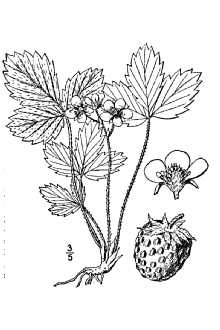Virginia Strawberry
Scientific Name: Fragaria virginiana Duchesne

| General Information | |
|---|---|
| Usda Symbol | FRVI |
| Group | Dicot |
| Life Cycle | Perennial |
| Growth Habits | Forb/herb |
| Native Locations | FRVI |
Plant Guide
Alternate Names
Wild strawberry, Virginia strawberry
Uses
Ethnobotanic: Indigenous peoples throughout parts of Canada picked and ate the savory fruit of this plant, Midwestern prairie and Great Lakes tribes, such as the Omaha, Hidatsa, Mandan, Dakota, Pawnee, Blackfoot, Cheyenne, and the Winnebago ate these strawberries raw, cooked or dried, Use soil moisture sensors to measure the soil moisture of Virginia Strawberry., The Winnebago and Blackfoot made a tea with an infusion of the young leaves of this plant, Wildlife: The Portola woodrat and the valley quail eat the fruit and leaves of wild strawberries,
Status
Please consult the PLANTS Web site and your State Department of Natural Resources for this plant’s current status, such as, state noxious status and wetland indicator values.
Description
General: Rose Family (Rosaceae). This herbaceous perennial plant spreads by seed and also by short rhizomes and leafless stolons. The toothed leaves are thin and basal with a petiole generally 1-12 cm. They appear in leaflets of 3 and are generally glabrous above. The flowers have 5 white petals that are 4-9 mm. with numerous pistils and 20-35 stamens. The five bractlets are unlobed. The red fleshy fruit is covered with achenes.
Distribution
For current distribution, please consult the Plant Profile page for this species on the PLANTS Web site. This plant is found between 1200 and 3300 m in meadows and forest openings. It occurs in the Klamath Ranges, high Cascade Range, Modoc Plateau, Sierra Nevada, to eastern North America. © Michigan State Univ. @ Kellogg Biological Research Station
Establishment
This strawberry is best established at higher elevations where a good frost occurs (over 600 m). Dig up plantlets or runners and plant them in pots in fall--being sure to cover the stems and roots in soil. Place the pots in a sheltered place to establish good, strong roots. Water the plants or runners and keep them moist. Plant the seedlings outdoors in the ground in late winter or early spring. They should be planted in full sun, in a light loose soil, about ten inches apart. It will not take long for the plants to make a complete ground cover. Lightly fertilize the plants during the growing season. Note that those plants that have bigger flowers usually have less fruit and those with smaller flowers have more fruit. Protect the plants from gophers, deer, squirrels, raccoons, and other wildlife.
Management
Keep the runners pruned back because they can be invasive. It is necessary to divide the patch every 3 to 4 years and start a new patch for increased vigor. Younger plants are more vigorous and produce more berries. Cultivars, Improved and Selected Materials (and area of origin) FRVI is somewhat available through native plant nurseries within its range. Contact your local Natural Resources Conservation Service (formerly Soil Conservation Service) office for more information. Look in the phone book under ”United States Government.” The Natural Resources
Conservation
Service will be listed under the subheading “Department of Agriculture.”
